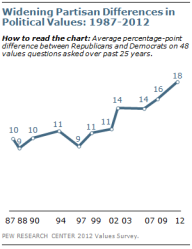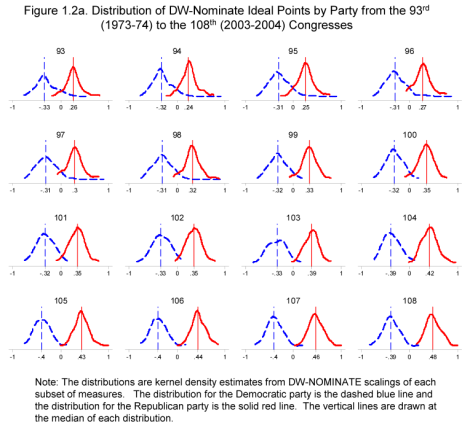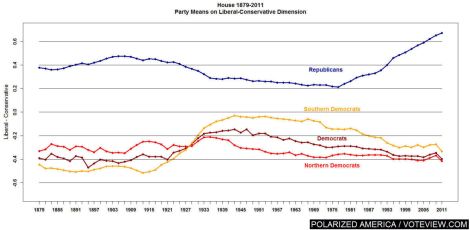It isn’t your imagination: Political polarization has risen sharply in recent years. The Pew Research Center confirmed it in a recent poll.
Interestingly, Pew’s survey shows no similar rise in polarization along racial, gender, or religious lines — only political affiliation. What seems to have happened is not a change in value systems but a sorting of those value systems into more ideologically cohesive political parties. Conservatives have become Republicans; liberals have become Democrats.
It’s not just self-identified partisans. Poll Watch notes that it’s happening to Independents as well: “Independents who say they lean — but are not committed to — either party have grown further apart from each other, particularly in their views on the role and effectiveness of government.”
This process — not any decline in “civility” or whatever — explains the passing of the supposed Golden Age of Bipartisanship. Cooperation across party lines used to be more possible because there were regional idiosyncrasies in the U.S., conservative Democrats in the South and liberal Republicans in the Northeast. Those idiosyncrasies are being ironed out and the parties are becoming more internally homogenous. What’s more, the process appears to be inexorable and irreversible. Polarization is the new normal.
This is well-understood by political types and even, I think, by the Average Joe and Jane. There’s just a lot more fighting now, a lot more heated tempers, petty sniping and point-scoring, hacks on TV yelling at each other. Americans are also sorting geographically, so personal exposure to other points of view is declining. Politics is becoming one of those things that you don’t mention in mixed company lest feelings get bruised.
What is much, much less well-understood is that the process of polarization is not symmetrical. The parties have not become equally ideologically homogenous or moved equally far toward their extremes. They do not behave in the same way or share the same attitude toward established social and political norms. Republicans have moved farther right than Democrats have left.
This is not just Some Blogger’s Opinion. Political scientists Keith Poole and Howard Rosenthal have done fascinating work on political polarization in Congress using a measurement of partisanship over time called DW-NOMINATE scores. (Click that link if you want to nerd out on the algorithms; it’s mostly about voting records.) The graph below shows what they found, going up to 2004. (I wish I had it extending to 2012; the trends have gotten more pronounced recently.) The humps are the distribution of Congresscritters in each party. The vertical lines under the humps are the mean point of each party’s ideological distribution. Each graph is a Congress; read left to right, top to bottom:
Two things jump out. First, over the 32 years leading up to 2004, the mean Dem moved six points to the left and the mean Republican moved 22 points to the right. Much farther! And second, there is virtually no overlap left between the parties. The humps have almost entirely separated. In short, the chart shows asymmetrical polarization.
For kicks, here’s another way to view it, focused on the House of Representatives (the Senate graph looks much the same). It shows the mean of each party over time and its distance from center:
Starting in the mid-’70s, Southern (read: conservative) Democrats started bailing and going Republican — thanks in no small part to Nixon’s “southern strategy” — and the GOP started getting more and more conservative. It is now considerably more conservative than the Democratic Party is liberal.
Anyway, so that’s the nerdy political-science version. Here’s how William Galston and Thomas Mann of the Brookings Institution describe the consequences:
[T]hese developments have not produced two mirror-image political parties. We have, instead, asymmetrical polarization. Put simply: More than 70 percent of Republicans in the electorate identify themselves as conservative or very conservative, while only 40 percent of rank-and-file Democrats call themselves liberal or very liberal. It is far easier for congressional Republicans to forge and maintain a united front than it is for Democrats. George W. Bush pushed through his signature tax cuts and Iraq war authorization with substantial Democratic support, while unwavering Republican opposition nearly torpedoed Barack Obama’s health-reform legislation. When Democrats are in the majority, their greater ideological diversity combined with the unified opposition of Republicans induces the party to negotiate within its ranks, producing policies that not long ago would have attracted the support of a dozen Senate Republicans.
Here’s the way I’d put it: Today, the national Democratic Party contains everything from the center-right to the far-left. Economically its proposals tend to be center to center-right. Socially, its proposals tend to be center to center-left. The national Republican Party, by contrast, has now been almost entirely absorbed by the far right. It rejects the basic social consensus among post-war democracies and seeks to return to a pre-New Deal form of governance. It is hostile to social and economic equality. It remains committed to fossil fuels and sprawl and opposed to all sustainable alternatives. And it has built an epistemological cocoon around itself within which loopy misinformation spreads unchecked. It has, in short, gone loony.
In April, Mann and longtime scholar of American governance Norman Ornstein, about the farthest thing from a leftie firebrand one can imagine, wrote an op-ed stating flatly, “Republicans are the problem.” They said:
However awkward it may be for the traditional press and nonpartisan analysts to acknowledge, one of the two major parties, the Republican Party, has become a resurgent outlier: ideologically extreme; contemptuous of the inherited social and economic policy regime; scornful of compromise; un-persuaded by conventional understanding of facts, evidence, and science; and dismissive of the legitimacy of its political opposition.
You’d think that such a striking perspective from two widely respected scholars of American governance would make a big splash. But the op-ed vanished virtually without a ripple.
Instead, pundits — and, to be fair, lots and lots of non-pundits — cling to the presumption of symmetry. Their minds rebel at asymmetry, especially extreme asymmetry. The notion that “partisans on both sides” are preventing a sensible middle course is deeply rooted to the point of catechism.
Maddeningly, when pundits actually lay out what that sensible middle course would look like, they end up describing Obama’s agenda. Benjy Sarlin at TPM put it best: “Pundits Urge President Obama To Back President Obama’s Proposals.”
- Jonathan Rauch urged Obama to adopt a plan of short-term stimulus, long-term debt reduction, and an extension on the debt limit. Ezra Klein notes that this is exactly what Obama has proposed.
- Thomas Friedman urged Obama to “go big” by raising taxes on the rich and endorsing a balanced long-term debt reduction plan. Greg Sargent notes, again, with feeling, that this is exactly what Obama proposes.
- David Brooks argues that Obamacare ought to limit the tax exclusion for employer-provided healthcare plans and offer subsidies for individuals to buy into regulated health insurance markets. Josh Bivens notes that Obamacare already does both those things and virtually everything else Brooks advocates.
- Michael Gerson says Obama should stop denying the economic crisis and propose a plan to address it, but not a plan that raises the deficit. Jonathan Chait notes that he isn’t, he has, and it doesn’t.
If mainstream pundits gave enough of a damn about energy to write columns about it, they’d no doubt urge Obama to support both renewables and domestic fossil fuels … which, of course, he already does.
Obama has issued fewer new regulations than Bush at the same point in his term. Where Bush grew the public sector, under Obama it has declined. He’s cut taxes. He’s put forward healthcare and climate legislation based on Republican proposals. Based on what he’s actually done and proposed, he’s effectively a moderate Republican — virtually the opposite of the caricature painted of him on the right. And yet “centrists” keep calling for a third party, for some brave leader to do what Obama is actually doing … presumably with more noble romanticism and less divisiveness. Or something.
If it’s hard for many folks to see the centrism already on offer from Obama, it’s also hard for the general public to see — to really understand — the radicalism on offer from the GOP. In the middle of Robert Draper’s recent New York Times Magazine piece on Priorities USA Action, a Democratic super PAC, comes this astonishing detail:
Burton and his colleagues spent the early months of 2012 trying out the pitch that Romney was the most far-right presidential candidate since Barry Goldwater. It fell flat. The public did not view Romney as an extremist. For example, when Priorities informed a focus group that Romney supported the Ryan budget plan — and thus championed “ending Medicare as we know it” — while also advocating tax cuts for the wealthiest Americans, the respondents simply refused to believe any politician would do such a thing. [my emphasis]
That is, of course, an entirely accurate description of the Ryan budget plan. It’s precisely what Romney and the congressional GOP have said they will enact. And yet when voters hear it, it sounds over-the-top, like fear-mongering.
My guess is that most voters wouldn’t believe that the GOP has embarked on a nationwide effort to disenfranchise low-income and minority voters, but that’s just what they’ve done. (Here’s the latest.) Most voters wouldn’t believe that Romney and the GOP want to end the Environmental Protection Agency as we know it, but that is precisely what they have said they will do; Romney has expressed only eagerness to work with the most anti-environmental House of Representatives in the history of the institution.
Jonathan Chait says, “I wouldn’t overread this and assume that the Republicans have found the ultimate wormhole, advocating policies so outlandishly unpopular that opponents can’t persuade voters they’re real.” That’s funny, ha ha, but they kind of have. Republicans have been getting more and more crazy, but they’ve kept winning. They’ve been packing federal courts, opening up politics to unlimited money, quashing attempts to revive the economy, opposing contraception for f’s sake, and it has not hurt them. It’s a 50-50 nation. Nothing much seems to change that.
Why, if the GOP has been radicalizing, have voters not seemed to notice? Kevin Drum says Republicans have been proposing outlandish crap for so long that people no longer take them seriously. Maybe there’s something to that. But surely there’s more than that going on.
Lots of people blame the political media. Lord knows there’s something to the way Politico-esque journalism has served to flatten politics into a blur of petty, tribal charge and counter-charge. But remember, most voters rarely encounter political media. They hear about politics through nightly network news, or not at all.
My theory is that centrism is a powerful psychological and social temptation, even in the absence of d-bag pundits pushing No Labels. Like I’ve often said, I think of centrism not so much as an ideology — how could it be ideology when it’s defined in relation to two moving targets? — as a temperament, a cultural identity. It springs from the (not entirely unreasonable) sense that partisanship is a kind of psycho-cognitive impairment that causes the sufferer to see only one side of an issue, to seek out only pleasing facts, to engage in motivated reasoning. It renders partisans unable to draw fair conclusions based on evidence. By transcending tribalism, centrists see more clearly.
Or so they like to think. And it’s not hard to see why: It’s a flattering and noble story to tell about oneself. Identity centrists are, nonetheless, human beings, and as such they are as subject to human foibles as the rest of us. Centrists can be as clubby and tribal as anyone. And they are just as prone to motivated reasoning. If you approach every question as a binary to be transcended, you can always find two “sides” to serve the purpose. This frequently manifests in unintentionally hilarious ways around climate change: One side says the Earth is flat, the other side occasionally exaggerates or insufficiently hedges, and the internet is choked with people claiming to be in the “reasonable middle” of that debate, despite sharing 95 percent of the substantive commitments of the latter side. They bend themselves into pretzels to avoid the obvious conclusion that all the reasonable debate is within one side — and they’re in it. Not above. In.
The U.S. cannot address its political challenges — and they are many — until its pundits, public, and politicians understand the shape of the situation we’re in. Asymmetrical polarization is the defining feature of American political life. As George Will might say, “deal with it.” The sides are drifting farther and farther apart, one far out into the choppy waters of reactionary lunacy. Those attempting to find a place between them are increasingly, well, at sea.






